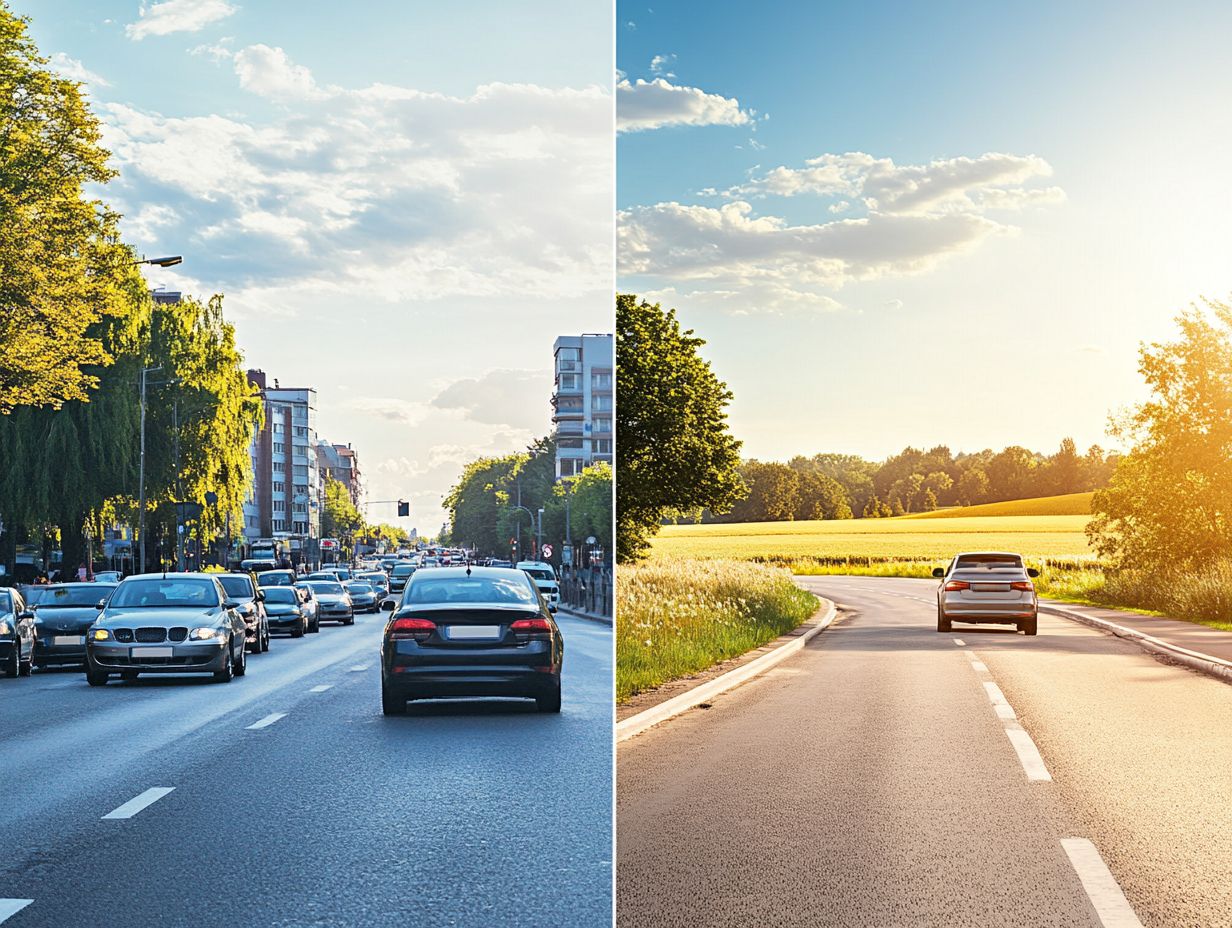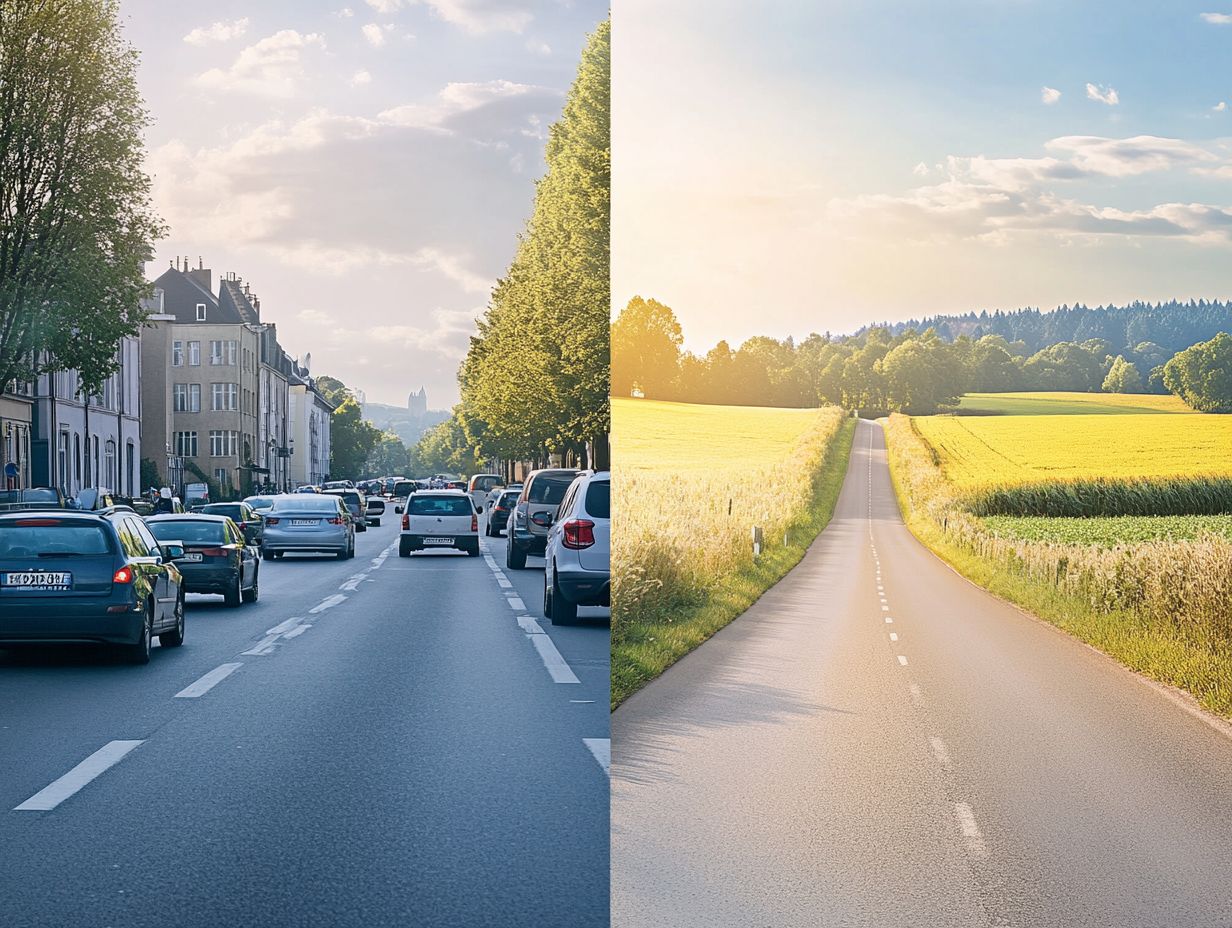How to Choose Coverage Based on Your Driving Environment
Your driving environment is essential in determining the ideal auto insurance coverage for you.
Numerous factors influence risk from the hustle and bustle of urban congestion to the serene yet unpredictable rural road conditions. By grasping the nuances of your surroundings, you can make informed decisions that significantly impact your policy choices.
This article delves into various types of auto insurance coverage, guiding you to select the best options based on your driving habits and locations. It also emphasizes key considerations such as weather, driving behavior, and budget.
Whether you re maneuvering through busy city streets or navigating winding country roads, securing the right coverage will grant you peace of mind on every journey.
Contents
- Key Takeaways:
- Understanding Your Driving Environment
- Types of Auto Insurance Coverage
- Choosing the Right Coverage for Your Environment
- Additional Factors to Consider
- Reassessing Your Coverage
- Frequently Asked Questions
- What factors should I consider when choosing coverage based on my driving environment?
- Why is it important to tailor my coverage to my driving environment?
- How does the type of roads I drive on affect the coverage I need?
- What kind of coverage should I get if I live in an area with extreme weather conditions?
- Do I need different coverage if I frequently drive long distances?
- How can I determine the best coverage for my driving environment?
Key Takeaways:

- Consider your driving environment when choosing coverage to ensure proper protection.
- Factors such as location, weather, and road conditions can impact the type of coverage needed.
- Regularly reassess your coverage to make sure it aligns with your driving habits and budget.
Understanding Your Driving Environment
Understanding your driving environment is crucial for understanding how auto insurance works. Your driving habits and vehicle diagnostics greatly affect your insurance premium.
By harnessing telematics data (data collected from your vehicle s systems), you gain valuable insights into your driving tendencies, which not only aids in assessing accident risk but also enables insurance companies to customize their offerings based on your driving scores and behaviors. This thorough analysis becomes a vital aspect of evaluating insurance policies, with an emphasis on enhancing customer satisfaction and incorporating driving feedback.
Factors to Consider
When assessing your driving habits, it s crucial to consider a variety of factors that influence your insurance rates and overall safety on the road.
Your driving history is a significant player in this game; a clean record often translates to lower premiums, while repeated violations can send your costs soaring. Speeding or reckless driving not only increases your risk of accidents but can also lead to higher insurance expenses.
You can also show cautious behavior by obeying traffic signals and keeping a safe following distance. Optimizing your mileage tracking and regularly evaluating your driving habits enhances your scores, which can lead to substantial insurance discounts. This not only benefits your wallet but also fosters a safer driving environment for everyone.
Types of Auto Insurance Coverage
Understanding the different types of auto insurance coverage is essential for choosing the options that best suit your needs. You ll encounter liability, collision, and comprehensive coverage, each serving a specific role in safeguarding you against potential risks on the road.
Together, these coverage types form the foundation of a robust auto insurance policy, ensuring you re adequately protected in various scenarios.
Liability Coverage
Liability coverage is your first line of defense in auto insurance. It s not just smart; in many states, it s the law! This coverage is often required by law in many states, with minimum limits that can vary widely from one jurisdiction to another. For instance, while some states may mandate a minimum liability limit of $25,000 for bodily injury, others set the requirement much higher.
The coverage level you select can significantly impact your insurance rates; typically, higher limits correlate with more expensive premiums. Insurers carefully evaluate accident risks when determining policy pricing, which means that a history of accidents can lead to increased costs.
By ensuring you have sufficient liability coverage, you not only comply with state regulations but also enjoy the peace of mind that comes from being financially prepared for any repercussions should you cause an accident effectively safeguarding your assets and future.
Collision Coverage

Collision coverage is your safety net on the road. It offers essential financial protection against damages to your vehicle resulting from a collision, regardless of who is at fault.
This type of coverage is particularly important if you want to protect your investment from unexpected incidents like accidents or collisions with other objects. When you file a claim, your insurance provider will assess the damage, and payouts will be tailored to the repair costs, ensuring you can regain your financial footing.
The cost of collision coverage is typically factored into your overall insurance premium. This reflects the risk associated with your driving history, the type of vehicle you own, and even your geographical location. Interestingly, vehicle diagnostics can significantly impact these rates. Specifically, safe driving behavior, monitored through technology that tracks safe driving habits, can help lower your premiums over time.
Insurers recognize that responsible drivers who maintain their vehicles in good condition pose a lower risk.
Comprehensive Coverage
Comprehensive coverage provides protection against a broad spectrum of risks that go beyond mere collisions, including theft, vandalism, and natural disasters.
This type of insurance policy is essential for protecting your valuable assets and ensuring that unexpected events won t lead to big money loss. While comprehensive coverage typically includes deductibles the amount you pay out of pocket before the insurance starts to help understanding these costs is crucial when selecting the right policy for your needs.
Remember that while some scenarios may be excluded, such as intentional damage or certain racing incidents, comprehensive policies can significantly alleviate the financial burden associated with accidents. By investing in comprehensive protection, you may even qualify for insurance discounts! Many providers reward those who choose extensive coverage with lower premiums.
This strategy not only bolsters your financial security but also brings peace of mind as you navigate the roads.
Choosing the Right Coverage for Your Environment
Selecting the right auto insurance coverage tailored specifically to your environment is essential. Factors like your driving habits, whether you’re cruising through urban traffic or navigating rural backroads, and even the weather conditions you encounter play a significant role in determining your insurance needs. For more insights, check out how to select coverage based on your situation.
By grasping these elements, you’ll be enabled to choose the most suitable coverage. This will help you effectively mitigate risks and drive with confidence.
Urban vs. Rural Driving
Urban driving presents a distinct set of challenges compared to rural driving, often leading to varying insurance rates and differing accident risk profiles.
In the vibrant chaos of city life, you ll find that traffic is denser, which inevitably increases the chances of collisions. As an urban driver, you re constantly maneuvering through complex road networks populated with pedestrians, cyclists, and various forms of public transportation. This creates a heightened risk for accidents.
Many urban areas have higher rates of vehicle theft and vandalism, which can significantly impact your insurance premiums.
On the other hand, rural drivers often enjoy the serenity of open roads with lighter traffic. This generally results in fewer accidents and potentially lower insurance costs. However, they may encounter unique risks, such as wildlife-related incidents, which can affect their coverage options.
Weather and Road Conditions
Weather and road conditions are critical factors in determining your safe driving practices. They can significantly influence your risk of accidents.
Rain, snow, and fog each pose distinct challenges that can impair your visibility, reduce traction, and slow your reaction times. This makes collisions more likely. As you navigate these unpredictable elements, your ability to adjust your driving behavior becomes essential.
These conditions demand your careful consideration when evaluating your insurance needs. For instance, if you frequently face inclement weather, it may be wise to adjust your coverage and premiums.
Insurers are keenly aware of the increased potential for accidents in such situations. Ultimately, grasping how weather affects your driving not only enhances your safety but also guides you in making informed decisions about your insurance.
Additional Factors to Consider

Beyond environmental factors, understanding your driving habits, budget, and coverage limits is crucial for making informed decisions about how to choose the best coverage for your needs in auto insurance.
Driving Habits and History
Your driving style and history directly impact your insurance rates and your potential risk of accidents. Insurance providers carefully review these factors when determining your premium costs.
For example, if you frequently speed or accumulate traffic violations, it may indicate a higher risk profile, leading to increased rates that could strain your budget. On the other hand, safe driving practices like obeying speed limits and avoiding accidents can result in more favorable insurance terms.
Showing responsible driving behavior can unlock significant discounts, making it financially beneficial in the long run. The benefits of maintaining a clean driving record extend beyond immediate savings; they can also increase your chances of obtaining better coverage options in the future.
Budget and Coverage Limits
Determining your budget and setting appropriate coverage limits are essential steps in effectively managing your auto insurance needs.
This process requires careful examination of your financial situation to ascertain how much you can comfortably allocate toward insurance premiums each month. Striking a balance between your desired coverage and your ability to pay is crucial, as it directly affects your peace of mind and financial stability.
Consider how factors like your driving habits and the safety features of your vehicle can influence potential premium adjustments. By adopting a sensible approach to budgeting, you can save money while ensuring you have the right protection tailored to your unique circumstances.
Reassessing Your Coverage
Periodically reassessing your auto insurance coverage is vital to ensure it aligns with your current driving habits and lifestyle changes. Consider how factors like changes in mileage, new driving behaviors, or shifts in accident risk may require adjustments to your coverage.
This proactive approach enhances your protection and helps optimize your insurance savings.
When to Make Changes
Understanding when to adjust your auto insurance policy can significantly enhance your savings and ensure you have the right protection for your circumstances.
For example, if your driving habits have changed perhaps you’ve taken on a longer daily commute or begun frequent road trips now is the perfect time to rethink your coverage needs!
Similarly, if you recently acquired a new vehicle, especially one with advanced safety features, you might be able to lower your premiums while boosting your protection.
These situations often coincide with regular insurance evaluation periods crucial moments to reassess your policies. By adjusting your coverage in response to such changes, you not only improve your financial efficiency but also contribute to comprehensive driving safety for yourself and everyone else on the road.
Frequently Asked Questions

What factors should I consider when choosing coverage based on my driving environment?
Important factors to consider include:
- The type of roads you drive on
- The weather conditions in your area
- The frequency and length of your trips
Why is it important to tailor my coverage to my driving environment?
Choosing the right coverage for your vehicle in your specific driving environment ensures that you have adequate protection in case of accidents or incidents that may occur.
How does the type of roads I drive on affect the coverage I need?
Driving on highways or busy city streets may require higher liability coverage to protect against potential damages to other drivers. Conversely, understanding how to match your coverage with your vehicle type may necessitate comprehensive coverage for protection against wildlife collisions on rural roads.
What kind of coverage should I get if I live in an area with extreme weather conditions?
Living in an area prone to severe weather? You need full insurance to protect against damage from hail, floods, and other natural disasters.
Do I need different coverage if I frequently drive long distances?
For long trips, it’s wise to have higher coverage limits. This protects you against potential accidents that may occur during those drives.
How can I determine the best coverage for my driving environment?
Talking to an insurance agent can truly help you understand your needs. They can assess your driving environment and recommend the right coverage based on your budget.





